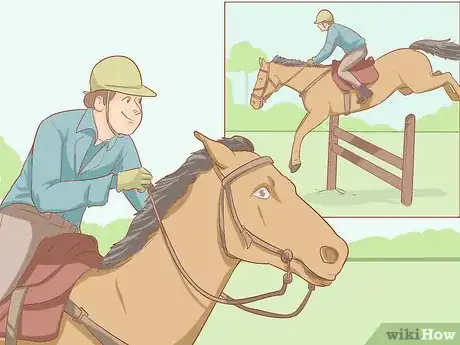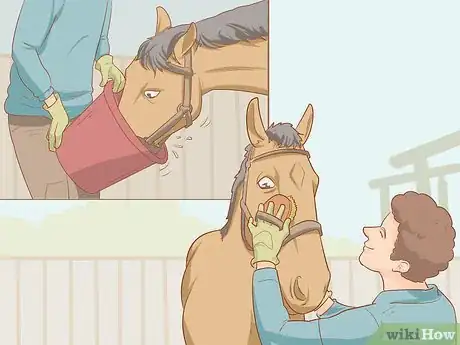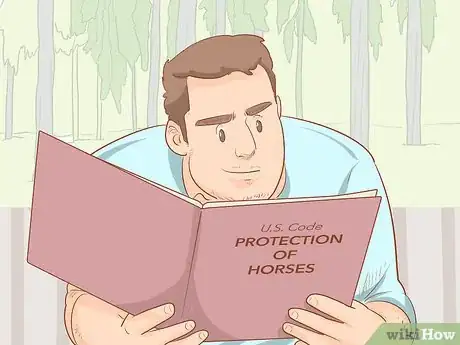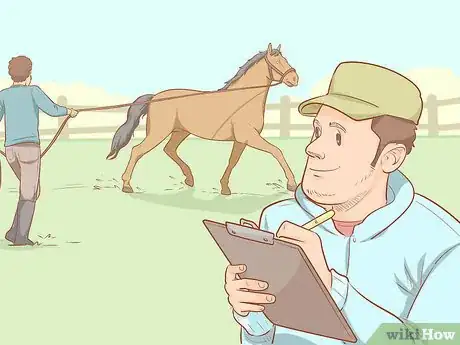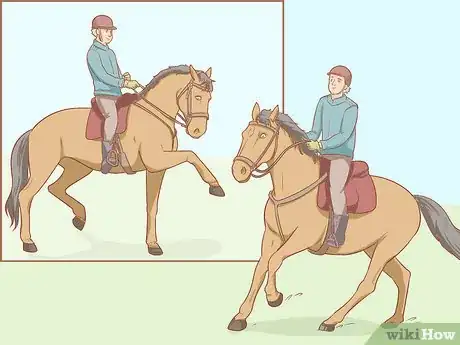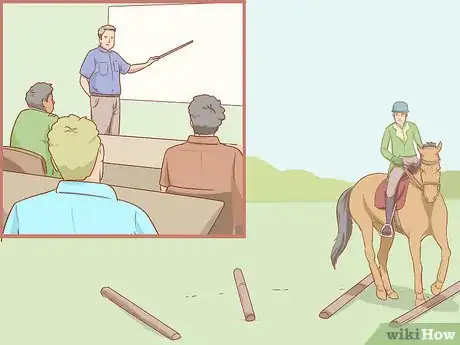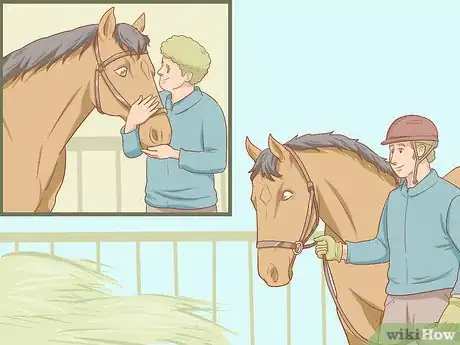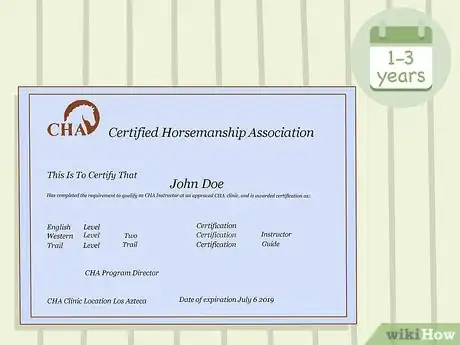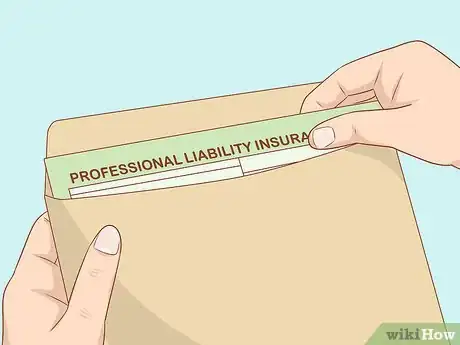This article was co-authored by wikiHow Staff. Our trained team of editors and researchers validate articles for accuracy and comprehensiveness. wikiHow's Content Management Team carefully monitors the work from our editorial staff to ensure that each article is backed by trusted research and meets our high quality standards.
There are 15 references cited in this article, which can be found at the bottom of the page.
This article has been viewed 78,872 times.
Learn more...
If horses are your first love, becoming a licensed riding instructor or coach could be the perfect way to channel your passion into a career. It can be hard to know where to start, however, as there’s no standardized set of requirements you must fulfill in order to be qualified to teach others. In most cases, earning the title of riding instructor involves seeking some type of certification through a nationally-recognized certifying body. Your certification will show that you have the knowledge and experience needed to pass on your skills to a new generation of riders.
Steps
Gaining Knowledge and Experience
-
1Build up as much experience as you can before going for your certification. As a riding instructor, you’ll need to know the ins-and-outs of horsemanship well enough to confidently teach them to others. It’s a good idea to focus on polishing your own skills before you even begin exploring your various certification options. Not only will this increase your chances of successfully passing your required exam, it will also make you a better instructor in the long run.[1]
- To make it as a riding instructor or coach, you’ll need to possess considerable know-how when it comes to riding, training, grooming, and caring for horses. You’ll also need to be able to think critically, communicate effectively, and explain concepts in a way that new students can understand.
- There’s no exact number of hours you must put in to be eligible to become an instructor—certification testing is the only method used to determine whether or not you have the necessary experience.
Tip: Talk to your instructor about the steps they took to get where they are, as well as what skills they use and value most in their profession.
-
2Request more responsibility at your riding school. If you’re currently enrolled at a riding school, ask your instructor or stable manager if there’s anything you can do to take a more active role in your lessons. For instance, you might volunteer to demonstrate skills, check new students’ equipment, set up courses, or stay late to help feed and clean up after the horses.[2]
- Getting involved at your riding school will give you a closer look at an instructor’s day-to-day duties while also building up trust between you and your teachers.
- If your instructor is impressed with your work ethic, they might even offer you a position after you’ve completed your certification.
Advertisement -
3Familiarize yourself with the laws pertaining to horses in your country. All countries have animal welfare laws governing the ownership, care, transport, and human treatment of horses and other animals. There’s no need to become an expert in horse law, but you will likely encounter a handful of legal questions on your certification exam.[3]
- Make sure you do your research to see if there are any other large animal or livestock laws specific to your state or territory. These laws could affect the way things like education, training, and business are conducted where you live.[4]
-
4Become an instructor’s apprentice as an alternative to certification. At some riding schools, students hoping to become instructors can take part in apprenticeship or internship programs to put them on the path to teaching themselves. As part of your program, you’ll be expected to serve for at least 6 months and/or log a minimum of 60 hours of direct instruction under your mentor, who must also be a licensed instructor or coach.[5]
- Some riding schools offer Assistant Instructor programs for paying students. These programs generally satisfy the same requirements and advertise the same benefits as a formal apprenticeship or internship.[6]
- Keep in mind that you’re not guaranteed the same sorts of opportunities with an apprenticeship that you would have with a national certification, since many employers will be looking for that stamp from the CHA or ARIA.
- One exception to the previous caveat is if you completed your apprenticeship with a prestigious riding academy, such as the Portuguese School of Equestrian Art or the Royal Andalusian School.
Earning Your Instructor Certification
-
1Look up organizations that offer certification training or testing in your area. Run a search for “riding instructor certification,” followed by the name of your town, city, state, or territory. Currently, there are only 2 organizations in the U.S. with certifications recognized nationwide: the Certified Horsemanship Association (CHA) and the American Riding Instructors Association (ARIA). However, you may also discover smaller local organizations offering generalized certifications.[7]
- A CHA, ARIA, BHS, or ABRS certification will be considered top credentials at any riding school or stables you may end up applying to.
- You may have no choice but to travel if there isn’t a physical location for your chosen certifying body near you. Distance learning or correspondence training and testing may be another option. These opportunities vary by organization.[8]
-
2Choose a discipline to receive your certification in. The equestrian arts are highly complex and specialized. For this reason, certifications are most often awarded for a single area or style of riding. In order to teach basic riding skills, all you’ll need is a recreational riding certification. Other disciplines you might consider include distance riding, dressage, reining, and stable management. There are even certifications for things like side-saddle riding, show jumping, and hunting with hounds![9]
- The major certifying organizations offer 3 separate levels of certification based on age and expertise: Level 1 is for instructors ages 18 and up in basic training; Level II permits instructors 21 years of age or older to take on beginner-to-intermediate-level students; Level III qualifies instructors above the age of 25 to teach advanced skills.
- The more certifications you have under your belt, the broader your wealth of knowledge and the more attractive you’ll be as an instructor.
- Defining your goals as an instructor can help you narrow down which discipline to pursue. A basic instructor certification is all that's required to teach recreational riders, for example, while you'll eventually need to seek certification in more advanced skills if you hope to one day work with competitive athletes.
-
3Take and pass a certification exam. Exams are typically one-day affairs that can be completed in a few hours. Most follow a written format designed to test your comprehension of riding skills, etiquette, terminology, and safety procedures. Testing will either be held on-site at the headquarters of the certifying body or at a third-party location, like a testing center or private conference room. Read through the testing policies of the certifying body you’ve chosen to learn more and find out how to schedule an exam.[10]
- Your riding instructor certification exam may be comprised of true/false, multiple choice, fill-in-the-blank, or short essay questions, depending on the organization giving it.[11]
- Certain exams may also feature other components, such as a verbal quiz or hands-on portion conducted in a classroom-type setting.
Tip: See if the organization you’re seeking certification through offers practice tests or similar study materials to help you prepare for your exam. If not, take some extra time to brush up on the fundamentals of riding, grooming, and the use of equestrian equipment.
-
4Attend a training program or seminar if your certification requires it. In some cases, prospective instructors can earn their teaching certification through intensive hands-on education rather than traditional testing. Training courses can last anywhere from a weekend to several weeks, and are structured to help students learn vital riding skills and principles. When it’s all said and done, you should have all the tools you need to pass you certification exam with flying colors.
- Call or visit the website of the certifying organization for more information on course requirements, availability, times and locations, and other details.[12]
- These types of programs have a limited capacity and tend to fill up quickly, so be sure to reserve your spot as far in advance as possible.
-
5Be prepared to pay up to $600 in certification fees. This is usually a one-time expense that all prospective instructors must pay for their first certification. If you’re only sitting for an exam, you’ll essentially be paying for the cost of the test and resulting certification. If you’ve chosen to attend a course or seminar, your fees will cover everything you need to complete your training, including lodging, meals, equipment, and animal upkeep.
- The entrance fee for your training program, course, or seminar may or may not include the cost of testing afterwards.
- If you decide to seek further certifications through the same organization later on, you’ll pay a reduced fee (usually around $300) for each one you earn.[13]
Acquiring Other Helpful Qualifications
-
1Rack up other certifications to add to your resume. Once you’ve obtained your basic riding instructor certification, consider returning to test for another skill level or discipline. While having multiple certifications isn’t a necessity, it will lend you added distinction in your field, which can give you a leg up when it comes to finding employment and taking on new students.[14]
- You might go out for a bareback riding, driving, or eventing certification to build on your fundamental riding knowledge.
- To take the quickest and easiest route to certification, stick with the same certifying body that issued your initial certification. You’ll already be familiar with their requirements and procedures.
- Follow-up certifications can be good opportunities to become officially credentialed in more specialized disciplines as you expand your skill set and evolve as an instructor.
-
2Seek out opportunities for continuing education. Keep an ear to the ground to find out about riding courses, workshops, and seminars taking place in your area, and act quickly to secure your spot when you find a program that interests you. Continuing education will give you the opportunity to sharpen your existing skills, become more confident in your teaching abilities, and pick up new tricks of the trade.[15]
- Be willing to travel to take part in exclusive continuing education opportunities. Courses led by noteworthy figures in the equestrian industry can make impressive additions to your list of credentials.
- The CHA also requires their instructors to submit proof of at least 25 hours of continuing education by the end of each 3-year renewal period.[16]
-
3Renew your certifications every 1-3 years as needed. The certifications issued by the major certifying bodies are only valid for a limited time. At the end of each period, the organization will send you a renewal form, which you’ll need to fill out and send back, along with any associated fees. Once you’ve done that, you’ll be good to go for another 1-3 years.[17]
- Annual certification renewal fees tend to only be about $25-30, on average. The total cost may be more for longer periods.
- There's no need to undergo further testing or provide proof of any additional qualifications (aside from your continuing education credits) once you've earned your certification.
-
4Apply for professional liability insurance. At the very least, you’ll need a basic Commercial Equine Liability policy. It will also be helpful to have a Care, Custody, and Control package if you think you might want to help board other people’s horses. A good insurance plan will protect you in the unfortunate event that one of your students or animals is hurt.[18]
- You can find more information on equine liability insurance online or in the back pages of your favorite equestrian publications.
Warning: Teaching without professional liability insurance could leave you vulnerable to costly lawsuits, damages, court fees, and other expenses.
References
- ↑ https://nationalcareers.service.gov.uk/job-profiles/horse-riding-instructor
- ↑ https://bluerider.org/programs/horsemanship/
- ↑ https://www.law.cornell.edu/uscode/text/15/chapter-44
- ↑ https://www.animallaw.info/intro/horse-laws
- ↑ https://www.mass.gov/files/documents/2017/12/18/ApprenticeshipRequirementsExpectations_0.pdf
- ↑ https://www.caw.ac.uk/careers/horse-riding-instructor/
- ↑ https://stablemanagement.com/articles/hiring-horse-riding-instructors-certification
- ↑ https://dressagetoday.com/instruction/distance-education-for-the-dressage-rider-53637
- ↑ https://www.riding-instructor.com/wp-content/uploads/2014/09/Cert.-Inf.-Booklet-9-1-14.pdf
- ↑ https://www.mass.gov/service-details/become-a-licensed-riding-instructor
- ↑ https://www.riding-instructor.com/wp-content/uploads/2014/09/Cert.-Inf.-Booklet-9-1-14.pdf
- ↑ https://www.riding-instructor.com/aria-instructor-certification
- ↑ https://www.riding-instructor.com/wp-content/uploads/2014/09/Cert.-Inf.-Booklet-9-1-14.pdf
- ↑ https://www.riding-instructor.com/wp-content/uploads/2014/09/Cert.-Inf.-Booklet-9-1-14.pdf
- ↑ https://www.usdf.org/education/instructor-trainer/fei.asp
- ↑ https://cha-ahse.netlou-secure.com/product_images/uploaded_files/Continuing_education_form.pdf
- ↑ https://www.mass.gov/files/documents/2017/12/14/RidingInstructorRenewalApplication.pdf
- ↑ https://www.equisearch.com/HorseJournal/yes-you-need-equine-liability-insurance-6627
